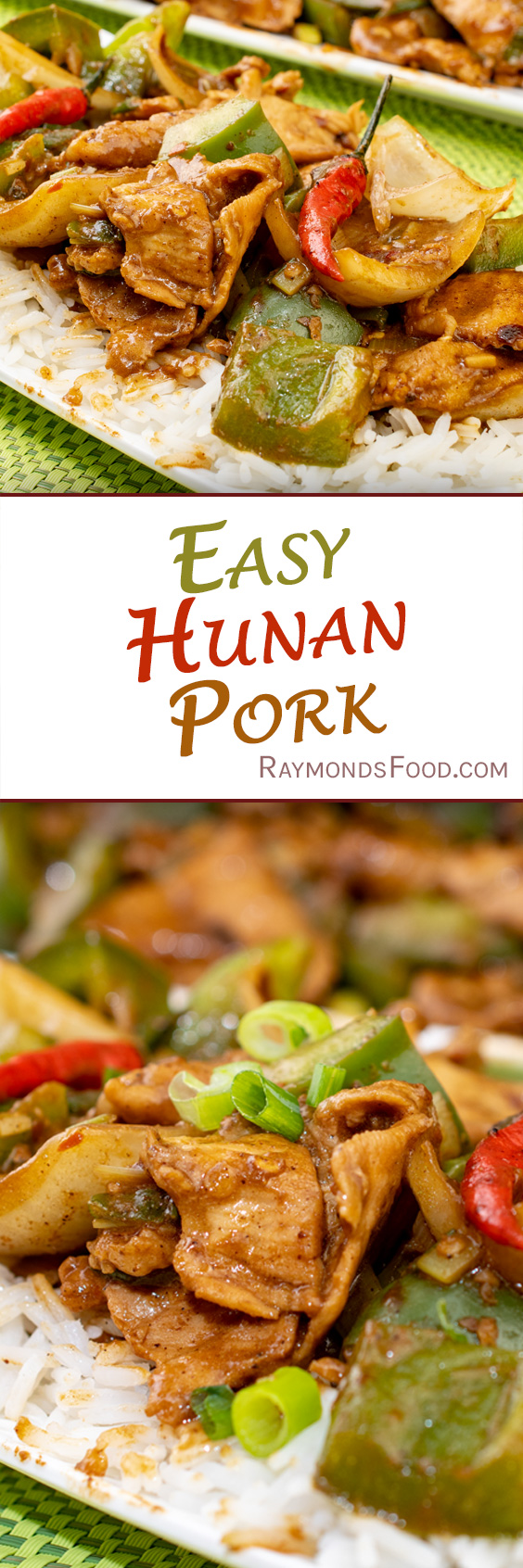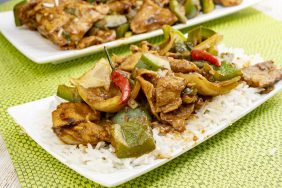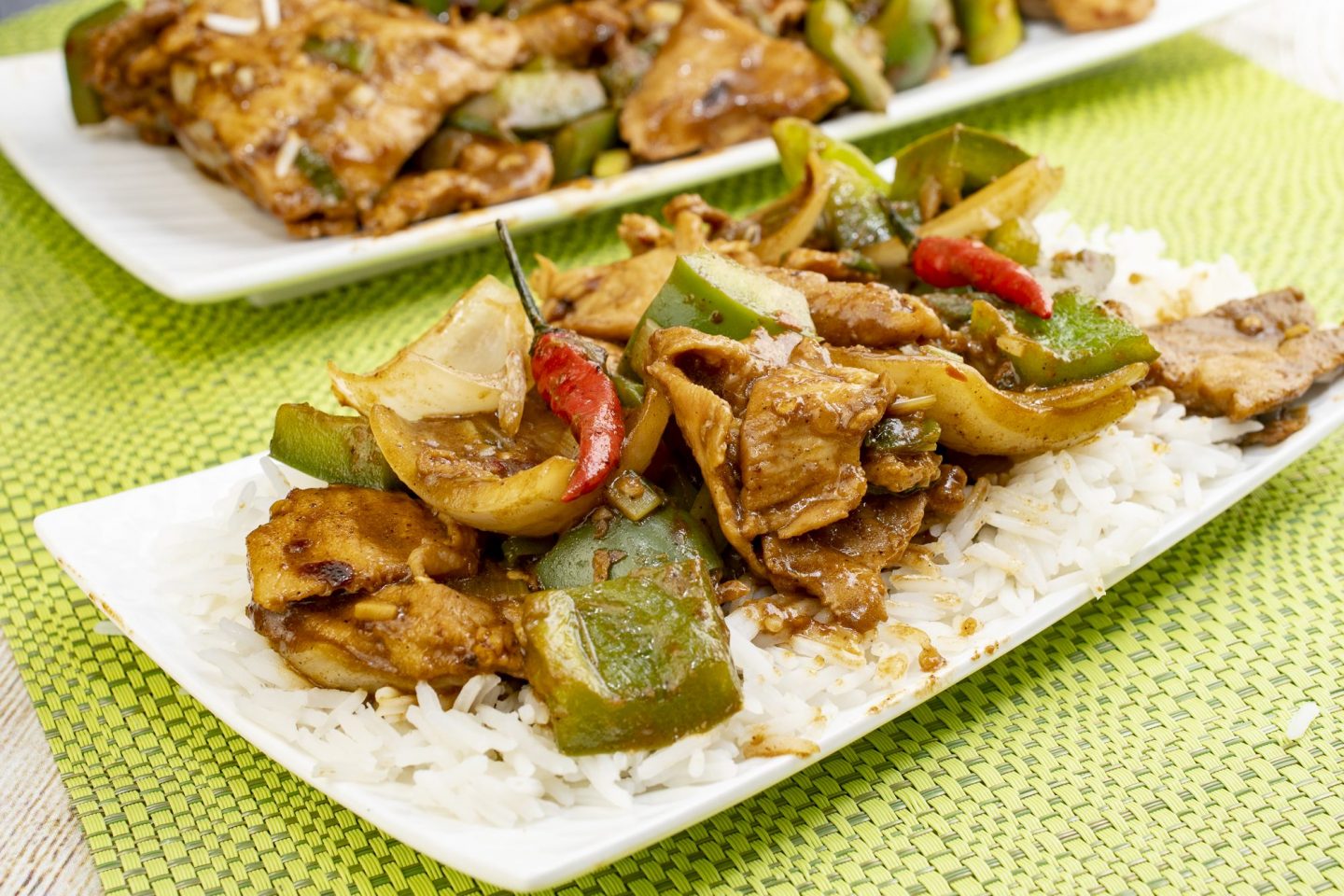Shaved Pork, Green Peppers & Onions in a Spicy Hunan Sauce

Or beef or chicken. Whatever’s cheap.
Discovering the Unique Taste of Hunan Shaved Pork
Hunan shaved pork is a unique and flavorful dish from the Hunan province of China. It is a spicy pork dish, made with thin slices of pork, marinated in a special sauce, and then stir-fried. The resulting dish has an intense flavor that is both savory and spicy.
Hunan shaved pork has a unique taste that cannot be found in other Chinese dishes. It’s spicy, yet still has the sweetness of the pork coming through. The combination of flavors makes it an unforgettable experience for anyone who tries it. With its unique taste, Hunan Shaved Pork is quickly becoming one of the most popular dishes in Chinese cuisine.
Hunan shaved pork has become increasingly popular in recent years as people are discovering its unique taste. While it may be intimidating to some due to its spiciness, it’s worth trying if you want to experience something truly different in Chinese cuisine.
An Overview of Hunan Pork & Its Place in Chinese Cuisine
The origin of Hunan pork dates back to the ancient times when Chinese people used to cook with pork as their Main source of protein. Over the years, Hunan pork has become one of the most popular dishes in China, especially in the province of Hunan. This dish is often served with vegetables or Noodles and can be cooked in various ways, depending on the tastes and preferences of each individual.
In this article, we will explore the unique taste of Hunan shaved pork, its cooking techniques and recipes, as well as its place in traditional Chinese cuisine. We will also discuss how you can make your own Hunan pork at home using some simple ingredients and techniques.
The Different Ways to Cook & Enjoy Delicious Hunan Shaved Pork Dishes
Hunan shaved pork dishes are a delicious and popular type of Chinese cuisine. With the right stir-frying, braising, and stewing techniques, With Hunan Shaved Pork, you can explore a range of delectable dishes that will surely delight your taste buds. Whether you’re looking for an easy weeknight meal or a more complex dish to impress guests, there is something for everyone when it comes to Hunan shaved pork dishes. In this article, we will explore some of the most popular Hunan shaved pork dishes as well as some tips and tricks on how to cook them up just right.
Hunan Pork Variations & Their Different Tastes
Hunan pork is a staple in many Chinese households and restaurants, and it can be prepared in many different ways. Hunan Pork has become popular in many parts of the world, and there are many variations of it. Hunan Pork comes in a variety of flavors, ranging from sweet & sour to the spicier ones. Every variation is distinct in its own special way and promises a delicious dining experience.
With the rise of fusion cuisine, cooks have started introducing new ingredients into traditional dishes like Hunan pork. This has opened up a world of possibilities for chefs to create new flavors and tastes that can tantalize the taste buds.
By introducing new ingredients into a traditional dish, cooks can create unique flavors that will tantalize their taste buds. This article will explore some of the different variations of Hunan Pork and their different tastes. and textures. Try Hunan Pork and Tomato Stir Fry with oyster sauce. This dish is a fiery, tangy, sweet and savory combination of tomato Sauce and oyster sauce that is served over rice. Fresh ginger root is added to this recipe for a touch of spiciness. The flavor of the dish comes from the chile peppers, cumin seeds, scallions and ginger root used in the stir fry along with other ingredients such as soy sauce and rice wine vinegar. You could use green onions or bell peppers instead if you prefer your food slightly more neutral in flavor.
A Comprehensive Comparison of Hunan and Szechuan Pork: How Do They Differ?
Hunan and Szechuan cuisine are two of the most popular styles of Chinese cooking. Each region has its own unique flavor profiles, ingredients, and signature dishes. In this article, we will explore the differences between Hunan and Szechuan pork dishes.
Hunan cuisine is known for its bold flavors and spicy dishes, such as the famous Hunan pork. On the other hand, Szechuan cuisine is known for its complex flavors and subtle spices, with signature dishes like Szechuan pork. Both cuisines have been enjoyed by many people around the world for centuries and continue to be a favorite among Chinese food lovers today.
Both regions have a distinct flavor profile that make them stand out from other regional cuisines. Hunan cuisine is known for its spicy and bold flavors while Szechuan cuisine is known for its hot and sour flavors.
The main ingredients used in both cuisines are pork, but they are cooked differently in each region. Hunan pork is usually cooked with chili peppers, garlic, and ginger to give it a spicy kick. On the other hand, Szechuan pork is cooked with chili peppers, garlic, and vinegar to give it a sour flavor.
The Spiciness Factor – How Hot are Hunan & Szechuan Pork?
Spice is an essential ingredient in many Chinese dishes, and Hunan and Szechuan pork are two of the country’s spiciest specialties. But how hot are they really? From the use of chili peppers to the unique flavoring of both dishes, we’ll explore what makes Hunan and Szechuan pork so spicy and how you can control their heat level to your own taste.
Hunan and Szechuan pork are both popular Chinese dishes that are known for their spiciness. Both dishes use a variety of chili peppers, which vary in heat level, to create a unique flavor profile. In order to determine how hot these dishes really are, it is important to understand the various types of chili peppers and how they contribute to the overall spiciness of the dish. This article will explore the various types of chili peppers used in Hunan and Szechuan pork, as well as how they affect the overall heat level of the dish.
Taste Comparison – What Makes Hunan & Szechuan Pork Unique?
Chinese cuisine is renowned for its unique array of flavors and spices, and two of the spiciest dishes are Hunan pork and Szechuan pork. These two dishes have a lot in common, but they also have their own unique characteristics.
When it comes to spicy Chinese cuisine, Hunan and Szechuan pork are two of the spiciest dishes. These two dishes are renowned for their unique array of flavors and spices, which are derived from chili peppers and other ingredients. The spiciness of these dishes can vary depending on the ingredients used and the cooking technique employed. In this article, we will explore the different flavors and spices that make these two dishes so popular among food lovers. We will also discuss how chili peppers contribute to their spiciness and why they are such a popular choice for those who enjoy spicy foods.
Ingredients
- 2 tbsp chinese cooking wine
- 1 tsp salt
- 2 tsp soy sauce
- 2 tsp dark soy sauce
- 1 tbsp corn starch
- 1-1 1/2 lb Pork Loin shaved (beef or chicken work too)
- 1 tbsp minced ginger
- 4 cloves garlic chopped
- 2-3 red chilis
- 2 tsp red pepper flakes
- 2 tsp cumin
- 3 green onion chopped, greens and whites separated
- 1 large green pepper chopped into 2″ pieces
- 1 large onion peeled, cut into eights
- 2 tsp sesame oil
- 4 tbsp water
- 1 cup rice cooked to package instructions
Instructions
- In a small mixing bowl combine the wine, salt, soy sauces, corn starch and 2 tbsp water. Whisk to combine, then add the meat and toss to fully coat. Set aside for at least 20 minutes
- Heat oil on medium high in a wok or large pan. Once shimmering add the meat and marinade and stir fry for 2-3 minutes. Remove the meat from the pan with a slotted spoon and set aside
- Add the green peppers, yellow onions and green onion whites and chiles to the pan. Stir to coat with the remaining meat stuff and stir fry for 2 minutes. Add the garlic, ginger, cumin and pepper flakes to the pan, stir fry for another 2 minutes.
- Add the remaining 2 tbsp water to the pan, stir to coat everything, then stir in the meat, cover and cook on medium-low another 2-3 minutes.
- Serve over rice
Nutrition






